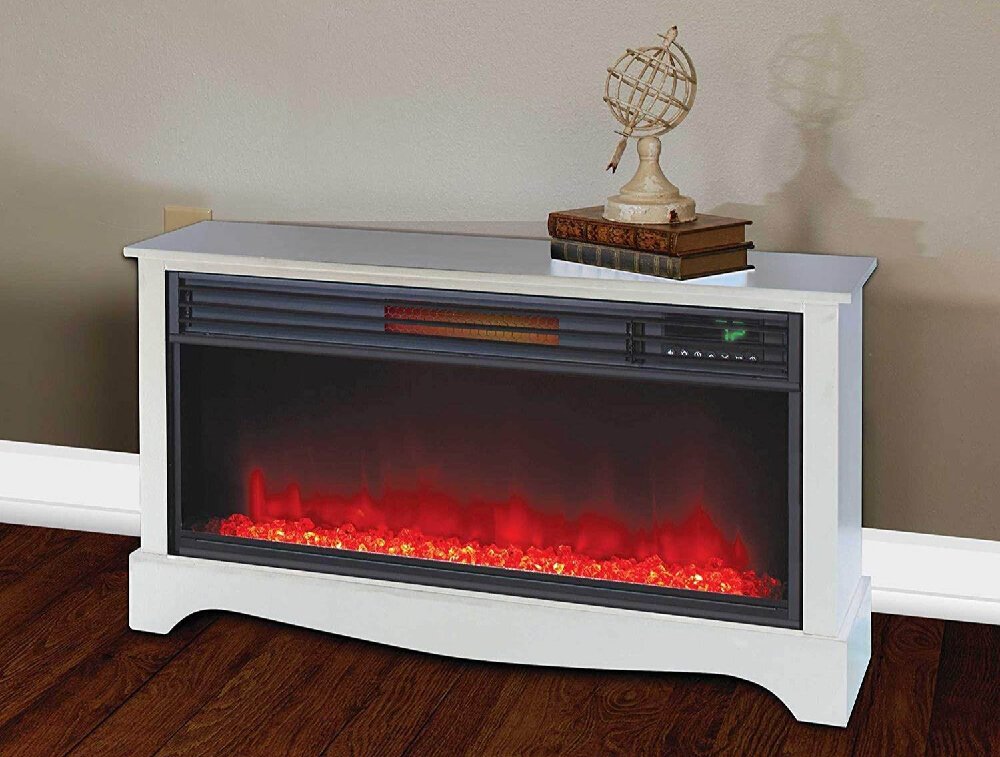If you’ve been shopping around for a supplemental heat source that looks permanent and enhances your home, you’ve undoubtedly seen fireplace-style heaters. You probably noticed that some of these fireplaces are labeled as electric while others are called infrared.
Learn more about the major differences between and shared benefits of electric fireplaces and infrared fireplaces, so you can make the best choice for your home.

Introduction
When it comes to keeping your home warm and toasty, there’s a fantastic variety of heaters guaranteed to light your fire. Two common types of heaters that you may want to consider are infrared fireplaces and electric fireplaces. These heaters differ in how they generate and distribute heat and come with their own pros and cons. In this article, we’ll turn the heat up on infrared and electric fireplaces to find out which is the hottest option for you.
How They Work
Electric fireplaces usually contain a heating element and a fan. When the electric fireplace is plugged into a wall outlet and turned on, the heating element gets hot. At the same time, the fan blows air across the element and pushes the now-hot air into the room. The cool air in the room is drawn in by the fan, and the process continues in a cyclical fashion.
Infrared fireplaces heat the air in a different way. Inside of these fireplaces, there is a bulb that produces infrared light, which is invisible to the naked eye. Coils surround the bulb, so the heat is distributed evenly, and a metal reflector sends the warm light rays into the room where they’re absorbed by nearby objects and people.
Fuel Source
As their name suggests, electric fireplaces are powered solely by electricity. Most electric units are compatible with residential 120-volt wall outlets, and their heating elements are constructed from chromium or nickel. Although electric fireplaces create a convincing simulation of a real fire, an LED light bulb in conjunction with a reflective mirror are responsible for the fire effects.
Many infrared fireplaces operate on electricity only. However, some models are powered by natural or propane gas; gas infrared fireplaces aren’t easy to move like electric ones. Electric infrared fireplaces create heat via a quartz bulb while gas infrared fireplaces utilize combustion to provide heat.
All infrared fireplaces use an LED light bulb and a reflective mirror to give the appearance of a fire, which means gas-powered infrared fireplaces still need a source of electricity.

Infrared Heaters—A spectrum
Infrared is part of the electromagnetic spectrum. It has a range of radiation waves of different wavelengths and frequency levels. Depending on where on the infrared spectrum it is, a heater will differ in the temperature range it covers, its heat transmission and absorption levels, and how it works over distances. There are three forms of infrared heat located at various points on the spectrum used for heating: near infrared, medium infrared, and far infrared. We’ll shine a light on these now.
Near Infrared Heater
Also known as short wave, bright, or IR-A, this type of heater emanates short radiation waves measuring 0.75 to 1.4 microns, producing high temperatures reaching up to 2372˚F. Although the waves have a high transmission (meaning they enter far into an object’s surface), they have low absorption. As a result, they’ll provide intense heat at a surface level but not at a deeper one. These heaters are helpful if you want continuous bursts of heat at a closer distance. Outdoor heating often uses this type of infrared and will emit a bright light while it’s operating.
Medium Infrared Heater
This infrared heater is also called medium wave or IR-B. In terms of depth of heat penetration, it’s comparatively less effective than the near infrared heater. This type of heater produces a deep-red light (like those seen with bar fires). Its radiation waves measure 1.4 to 3 microns long, and its maximum temperature output is around 500°C-800°C. As a result, it’s best suited to situations where a surface needs to be rapidly heated. Therefore, it’s not usually used for home heating purposes and instead is utilized in industrial processes.
Far Infrared Heater
Far infrared heaters, also known as dark radiators, longwave, or IR-C, produce lower frequency waves and longer heat waves that measure more than 3 microns. They radiate at lower temperatures than the other infrared heaters—typically below 100°C. As such, they’re arguably the best type of comfort heating; their low transmission waves are gently absorbed and use less energy to heat effectively. Additionally, these types of heaters don’t emit any light at all.
Coverage Area
One of the biggest concerns people have when deciding what kind of portable fireplace to buy is the number of square feet it will cover. Typically, electric fireplaces disperse heat in areas about 400 to 500 square feet. The higher the fireplace’s BTUs, the more space it can cover. Therefore, electric fireplaces are great for bedrooms and enclosed living rooms.
Infrared fireplaces cover a larger area than non-infrared electric fireplaces. The average infrared fireplace heats rooms as large as 1,000 square feet, making them suitable for open areas like living room/dining room combos. Even though these fireplaces cover twice as many square feet as electric fireplaces, the space directly in front of the fireplace receives the most heat.
Heating Time
Electric fireplaces circulate air with a fan, producing a convection current.
As such, it can take about 20 minutes for one of these fireplaces to heat a room. The wait time is slightly longer if the fireplace contains a sealed element. The trade-off to its somewhat slow heating time is the air stays warm for a good hour or so after you turn off the fireplace, which helps you save money on electricity costs.
The heating time of an infrared fireplace is much faster than that of an electric fireplace. In fact, you’ll almost instantly feel the heat when you turn on an infrared fireplace.
If you want a heat source to knock the morning chill from the air or to use in emergency HVAC situations, an infrared fireplace is an excellent choice. As quickly as an infrared fireplace provides heat, the heat leaves just as fast. When you turn off an infrared fireplace, the heat won’t linger because objects and people absorb the heat.

Energy Efficiency
Here is an area where electric fireplaces really shine. The energy efficiency of a heater is determined by how many kilowatts of heat it pushes out compared to how many kilowatts of electricity it uses.
An electric fireplace with a 1 to 1 ratio is considered to be 100 percent efficient. Most electric fireplaces come close to a 100-percent efficiency rate, and infrared fireplaces are almost as efficient.
These fireplaces also have an LED light to make the logs, embers, and faux flames glow. LED lights are just as energy efficient as the fireplaces themselves. They also last for a long time, boasting a lifespan of several years or more.
Related Post: Indoor Electric vs. Natural Gas Space Heaters
An infrared fireplace is 40% more efficient than a electric fireplace. Therefore we can conclude that a 500-watt infrared fireplace can produce the same level of heat as a 1200-watt electric fireplace.
Comparison of the running cost of 500-watt infrared vs 1200-watt electric fireplace
| Infrared Fireplace | Electric Fireplace | |
| Wattage rating of appliance (in Watt) | 500 | 1200 |
| Total units used per hour (kWh) | 0.5 | 1.2 |
| Per hour running cost | $0.06 | $0.15 |
| Per day costing (5 hours) | $0.30 | $0.70 |
| Total running cost in winter | $36.00 | $90.00 |
Level of Safety
Electric heaters and infrared fireplaces are extremely safe. Neither type of fireplace emits pollutants like smoke, which is great news for allergy and asthma sufferers. This also means that the smell of smoke won’t permeate your carpet, upholstery, and clothes.
Both fireplaces are also safe to use around children and animals. Their housing always stays cool to the touch. An electric fireplace’s heating element does get hot, but it’s inaccessible. Plus, a lot of electric and infrared fireplaces are equipped with a timer to prevent the risk of the overheating.
The only health advantage infrared fireplaces have over electric ones is their effect, or lack thereof, on the air. The fan inside of an electric fireplace eventually dries out the air, which may bother your sinuses. However, this is a non-issue with infrared fireplaces.

Design
According to your style, taste, and size of your home, there’s an eclectic and broad range of electric fireplaces to choose from. Perhaps you’re going for a more traditional look, in which case you can find an electric heater to mimic the fireplaces of old. Many brands produce models that imitate the look and sounds of a crackling, open fireplace—flames and all. Perfect for a cozy and romantic ambiance. There are also more modern designs that can be wall-mounted or left freestanding. Whatever your needs or requirements, you’ll be able to find the perfect electric fireplace to effectively heat your living space and look stylish too.
Although infrared heaters can come in compact shapes and sizes to fit in with any space, they lack the pizazz and style options of their electric counterparts. Aesthetically speaking, they tend to be drab and uninspiring and don’t add much to a living space apart from exceptional heating. Their limited design means they can’t provide the same fake fireplace effects as an electric heater—a disappointment for homeowners looking for an attractive centerpiece.
Therefore, if style is an essential priority for you, it might be worth looking into electric heaters rather than infrared ones. Electric fireplaces offer more variety in terms of their design and look, allowing you to fan the flames of your creativity. Infrared heaters, although energy-efficient and highly functional, lack the design flair found in electric versions.
Heaters and Health Issues
When choosing heaters for your home, it’s important to consider the health implications of using such devices. As mentioned earlier, electric fireplaces work by pushing heat out and around a room using electric fans. Unfortunately, while heating up your home, they also reduce the humidity (or moisture) in the air, potentially causing health problems.
Breathing in dry air can exacerbate or create respiratory issues such as asthma or bronchitis. The mucus membranes of the nose and mouth—a crucial part of our body’s defense against dirt and viruses—will also dry out. This means you’ll be more prone to illnesses or infections. Additionally, electric heaters tend to dry out our skin and eyes, leading to irritation and discomfort. Other issues to consider are the risks of static electricity and fire. You need to ensure that any flammable items such as carpeting or upholstery aren’t left too close to the fireplace’s heating element.
With infrared heaters, these health risks are diminished. This is because infrared heaters don’t decrease your living space’s humidity or oxygen levels—they merely radiate heat. You won’t find yourself suffering from nasty side effects such as headaches, coughs, dry eyes, or static electricity shocks. So, when it comes to effectively keeping warm without putting your or your family’s health at risk, an infrared heater might be the hottest option.
Heat Comfort
Imagine it’s a cold but sunny winter’s day. You move from a chilly, shaded area to stand under the warm glow of the sun. You quickly start to feel cozy and snug. Using an infrared heater to warm your home feels equally satisfying. Infrared heaters emit radiant heat, much like the sun does, to gently warm you up and keep you at a comfortable temperature. The air in your room makes you feel as though you’re basking in natural warmth.
On the other hand, electric heaters pull in cold air, warm it up, and push it out again. Rather than providing gentle, long-lasting heat, they tend to deliver quick blasts of hot air. This hot air will rise to the ceiling, and as it falls, it cools down. More often than not, you’ll find yourself with a stuffy head and cold feet as the air fails to circulate properly. Add to this the fact that electric heaters reduce oxygen and moisture levels. You can potentially harm your health and start to feel more than uncomfortable.
Overall, infrared heaters provide a more satisfying, natural-feeling level of warmth for a longer period, without the unwanted health impacts associated with electric heaters. Using an infrared heater will feel like a more natural way of keeping yourself and your loved ones warm.
Other Shared Benefits
From installation to maintenance, electric and infrared fireplaces share many of the same benefits. Gas-powered infrared fireplaces and wall-insert units aside, electric fireplaces and electric-only infrared fireplaces aren’t complicated to install.
All you have to do is plug them into the nearest electrical outlet, and you can move them whenever you want.
Since the light effects work separately from the heat, all of these fireplaces can be used throughout the year, even in the summertime. They also come in almost any style imaginable, such as mantels, consoles, compact units, comer units, and wall inserts.
Electric and infrared fireplaces require little maintenance. As opposed to wood-burning fireplaces, infrared and electric units don’t produce ash that you have to sweep, and you don’t need to add wood or stoke the fire constantly.

Summary
In this article, we’ve reviewed the benefits and disadvantages of electric and infrared heating. Overall, infrared fireplaces extinguish the competition regarding their heat comfort level and lack of adverse health impacts. Although both types of heating are energy-efficient (turning all the electricity they use into heat), infrared heaters tend to run just as effectively at a lower cost. The only aspect where electric heaters outshine infrared versions is in their design.
Electric heaters draw in cold air from a room, heat it with internal heating coils, and then expel it back into the room using a fan. Electric heaters don’t directly heat the thermal mass of a room (the walls, ceilings, and floor). They simply heat up volumes of air which are then “carried” around a room. A drawback to this? Heat rises and cools as it falls, also escaping through cracks or open doors. As the air is drawn back to the heater, it’ll already have lost most of its heat. This isn’t an efficient way to ensure warmth is distributed evenly throughout a room or retained for as long as possible.
Infrared heaters are a type of electric heater that uses infrared technology to heat a room. Rather than heating the cold air drawn into it, an infrared heater converts electricity into radiant heat. It generates concentrated beams of heat particles that instantly warm up the thermal mass they’re focused on. The warming effect is much like the heat radiated by the sun and results in quicker and deeper absorption. An infrared heater will be more efficient in heating a room and keeping that room warm.
Many electric heaters work by automatically turning off once the required temperature in the room has been achieved, using a thermostat or a timer. They tend to take relatively longer for their warming effects to be felt, but these can last for a while (provided that no doors or windows are open).
The heat from an infrared heater will start to be felt almost instantly and works by warming the objects its infrared radiation touches. An infrared heater is ideally used for directional heating for a shorter period. They are less effectively used for large spaces, as there’s no fan to push the warm air around the room. Plus, once they’re turned off, the room will start to cool down. Unlike electric heaters, they rarely come with the option of a timer or thermostat.
Bearing this in mind, electric heaters tend to be more effective for heating larger areas over more prolonged periods. They’re handy for vast spaces such as warehouses or rooms where you don’t want to sit too close to the heating source. However, infrared heaters can be used as great supplements for central heating in rooms or areas that don’t require sizeable spaces to be warmed up.
If you’re searching for a viable heating option for your home that won’t burn a hole in your bank account, you’ll do well to check out some infrared models. Not only will you and your family stay warm and snug during the winter months, but you’ll save money on energy bills (and avoid potential trips to the doctor).
If you have any questions or comments, please add them below in the comment section. Similarly, please let us know if you spot any mistakes or omissions. Thanks!
Last Update: 2024-04-17 | Affiliate links/Images from Amazon Product Advertising API






